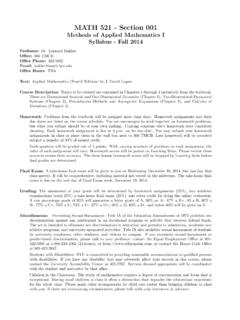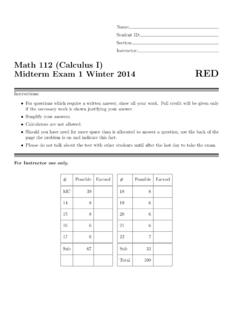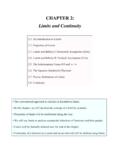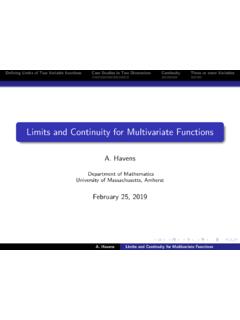Transcription of Math 314 Lecture #12 14.2: Limits and Continuity
1 Math 314 Lecture #12 : Limits and ContinuityOutcome A: Recall and apply the definition of limit of a function of several a function of two variables whose domainDcontains points arbitrarily close tothe point (a,b).We say thelimitoff(x,y) as (x,y) approaches (a,b) (within the domainD) is thenumberLand we writeL= lim(x,y) (a,b)f(x,y),if for every number >0 there exists a corresponding number >0 such that for allpoints (x,y) Dwithin a distance of from (a,b) there holds|f(x,y) L|< .There are infinitely many ways for a point (x,y) to approach (a,b): straight line ap-proaches, quadratic and cubic approaches, squiggly approaches, spiral approaches, are illustrated for (x,y) approaching (0,0).When the limitLexists forf(x,y) as (x,y) approaches (a,b), EVERY approach of (x,y)towards (a,b) gives the same limiting value the other hand, when there are two different approaches of (x,y) towards (a,b) thatgive different limiting values off, then the limit offas (x,y) approaches (a,b)does the limit, if it exists, or show that the limit does not exist.
2 (a) lim(x,y) (1,0)ln(1 +y2x2+xy).Since the natural log function is continuous on its domain, we havelim(x,y) (1,0)ln(1 +y2x2+xy)= ln(lim(x,y) (1,0)1 +y2x2+xy),provided the limit on the right exists and is bigger than numerator and denominator of the fraction are continuous functions, and so by thequotient rule for Limits we havelim(x,y) (1,0)1 +y2x2+xy=lim(x,y) (1,0)1 +y2lim(x,y) (1,0)x2+xy=11= we obtain the limitlim(x,y) (1,0)ln(1 +y2x2+xy)= ln(1) = 0.(b) lim(x,y) (0,0)xy3x4+ the numerator and the denominator evaluate to 0 as (x,y) approaches (0,0), andso we have a 0/0 situation (but no two variable l Hospital s rule unfortunately).If we suspect the limit does not exist, we choose different approaches to see if we getdifferent limiting approaches are determined byy=mxfor a constantm, where (x,y) =(x,mx) approaches (0,0) asx substitution ofy=mxsimplifies the limit:lim(x,y) (0,0)xy3x4+y6= limx 0x(mx)3x4+ (mx)6= limx 0m3x4x4(1 +m6x2)= limx 0m31 +m6x2= different straight-line approaches give different limiting values, and so the limitdoes not exist.
3 (c) lim(x,y) (0,0)x2yeyx4+ (0,0) along thex-axis, , settingy= 0, giveslim(x,0) (0,0)x2yeyx4+ 4y2= lim(x,0) (0,0)0x4= (0,0) along they-axis, , settingx= 0, giveslim(0,y) (0,0)x2yeyx4+ 4y2= lim(0,y) (0,0)04y2= might suspect that the limit could be 0, but along the quadratic approachy=x2, , (x,x2) (0,0) asx 0, we getlim(x,y) (0,0)x2yeyx4+ 4y2= limx 0x2x2ex2x4+ 4(x2)2= limx 0x4ex25x4= limx 0ex25=156= limit does not exist because there are two different approaches that give differentlimiting values.(d) lim(x,y) (0,0)x2sin2yx2+ probe the limit by the straight-line approachesy=mxwhich giveslim(x,y) (0,0)x2sin2yx2+ 2y2= limx 0x2sin2mxx2+ 2m2x2= limx 0sin2mx1 + 2m2= might suspect that the limit exists and is equal to justify this, we notice that since 0 x2x2+ 2y2 1, we have the inequalities0 x2sin2yx2+ 2y2 Limits of the outer two functions as (x,y) (0,0) are both 0, and so the SqueezeTheorem tells us thatlim(x,y) (0,0)x2sin2yx2+ 2y2= notion of the limit of a function of two variables readily extends to functions of threeor more B: Recall and apply the definition of Continuity of a function of several functionfof two variables iscontinuous at a point(a,b) in its domainDiflim(x,y) (a,b)f(x,y) =f(a,b).
4 A functionfiscontinuous on its domainDif it is continuous at every point (a,b) ofits definitions extend readily to functions of three or more polynomial innvariables is continuous on its domainD= the set of points on whichf(x,y,z) = yx2 y2+z2is be continuous, the numerator gives us the restrictiony 0, and the denominatorgives us the restrictionx2 y2+z26= is, the function is discontinuous wheny<0 or whenx2 y2+z2= 0, , the point(x,y,z) lies on the coney2=x2+z2.









